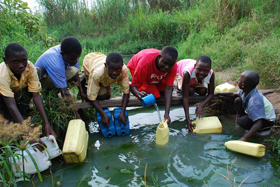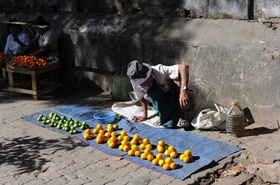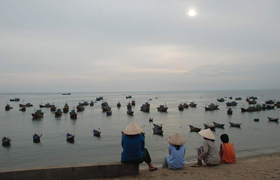International Development Assistance in the New Economic Environment
(no votes) |
(0 votes) |
Expert on Development Assistace
The falling funding levels for international development in 2011 as a result of the global economic crisis is both a challenge to international aims of reducing poverty and a stimulus for the debate on the future of the international architecture for development assistance.
The falling funding levels for international development in 2011 as a result of the global economic crisis is both a challenge to international aims of reducing poverty and a stimulus for the debate on the future of the international architecture for development assistance.
Lower Development Assistance Budgets: Necessity or Strategic Blunder?
In October 1970, the United Nations General Assembly adopted Resolution number 2626, International Development Strategy for the Second United Nations Development Decade, under which donor countries undertook to allot at least 0.7 percent of their gross national product (GNP) to international development assistance, in order to achieve the Resolution’s goals by 1975. In 2000, this commitment was reiterated by the UN Millennium Summit, and at Gleneagles in 2005 the G8 came to an agreement to annually increase the volume official development assistance (ODA) funding by 50 billion dollars to 2010, from 2004 levels. In particular, the G8 pledged to augment its aid to Africa by 25 billion dollars annually up to 2010.
In 2011, OECD Development Assistance Committee (DAC) member countries on average allocated just 0.31 percent of GNP, or a total of 133.5 billion dollars to help achieve development goals. Furthermore in 2011, total assistance in real terms was 2.7 percent lower than that seen in 2010, the first fall since 1997. This drop in assistance from traditional donors prompted a barrage of criticism from the expert community, while some analysts even stated that the boom in international development assistance of the early 2000s was over.
Those who back cuts in development budgets, argue that, due to the painful austerity measures that are inevitable given the national budget deficits, diverting taxpayers' money to help out other countries.
In 2011, the greatest rise in development assistance in real terms was seen in Italy, New Zealand, Sweden and Switzerland. By comparison, help from 16 other DAC members went down, with Austria, Belgium, Greece, Japan and Spain imposing the biggest cuts. The largest donor in absolute terms (30.7 billion dollars), the USA, trimmed its aid budget by 0.9 percent compared to 2010 levels, while 12 EU countries also lowered their ODA budgets, among them Greece – by 39 percent, and Spain – by 32 percent. And only five countries – Denmark, Luxemburg, the Netherlands, Norway and Sweden – reached the pledged level of the 0.7 percent of GNP.
Due to the Eurozone economic crisis and the budget deficits that many donor countries currently face, the debate on the wisdom of spending 0.3 to 1.0 percent of the state budget on development assistance is becoming really heated.
Those who back cuts in development budgets, argue that, due to the painful austerity measures that are inevitable given the national budget deficits, diverting taxpayers' money to help out other countries is a luxury that can no longer be afforded. In the United States, many are calling for a partial shift in development funding, away from the government to a private-public mechanism.
Their opponents include both pragmatics and romantics. Regarding the ODA as a key tool of soft power, the former say that that these expenses account for a minute proportion of the state budget, and that while cuts would do little or nothing to alleviate the effect of the crisis, they would have an impact on the country’s global strategic interests. The latter base their argument in humanitarian issues, maintaining that the relatively small amounts (against the entire state budget) go to finance programs that save millions of lives worldwide (food assistance, the fight against HIV/AIDS and malaria, etc.).
There is one more essential factor with which those on either side of the debate must interact, i.e. public opinion. In most donor countries the public is still quite positive about international development assistance. However, recession and the inevitable knock-on cuts in government spending may easily reverse the public mood, and this is something that politicians throughout these countries will have to take into consideration.
It seems too early to adequately assess the full impact of the deepening Eurozone crisis for national budgets and the ODA. But the OECD’s analytical forecast for years 2012-2015 predicts that a modest rise in total ODA for 2012 (thanks to preferential credits from the World Bank and regional development banks, achieved thanks to the money that has been pumped into these structures over the past several years) will be followed by a gradual decline related to the delayed effect of the crisis on ODA budgets in most OECD countries. The latest global economic forecast by the International Monetary Fund also leaves no illusions about more generous development assistance budgets in the near future.
At the same time, DAC statistics do not include data on countries outside the Committee, such as the BRICS states, that have been boosting their ODA spending recently, primarily China and India.
Lower ODA will undoubtedly have an impact on the Millennium Development Goals, the eight global goals in international development for the period up to 2015 established by the UN Millennium Summit in 2000. Some experts view it as fundamentally unrealistic to expect to achieve these goals, especially those which seek to halve the proportion of people living in extreme poverty and reduce infant and maternal mortality within the declared time limits (according to some assessments, this would take dozens of years).
This reduced assistance has already been felt by African countries where the state budgets are highly dependent on foreign aid (in 2009, the budgets of 30 countries, primarily in Africa, were over 30 percent foreign allocations). Hence, lower or discontinued aid may generate a partial collapse of government functions in recipient countries.
Apart from the need to cut development aid, issues related to the overall expediency of this assistance, its effectiveness and architecture for the 21st century, are still debatable.
The Assistance We Need for the 21st Century
In order to ensure the assistance offered stimulates economic growth the recipients should display more initiative, for example by mobilizing domestic reserves, attract foreign direct investment, and foster small and medium- sized business.
The global development assistance architecture that was established during the second half of the 20th century is undergoing irreversible change. First, today’s global model features diverse actors, including state development agencies, across both traditional and new donor countries. Second, the concept of developing countries and third-world countries as a uniform conglomerate of chiefly African and Asian states that existed in the second half of the 20th century, is rapidly fading. Third, there has been a change in the North-South assistance vector. The economic strengthening of the BRICS states (especially India and China) has seen them turn from being recipients to being donors, with South-South cooperation gaining momentum. In recent years, certain African countries have also displayed economic growth against the stark backdrop of crisis in the Eurozone. At the same time, some experts believe that in the 21st century the majority of people below the poverty line will be found in fragile states.
Mankind seems to have come to an understanding that the ODA by itself will not solve global problems, eradicate poverty and inequality, given current global poverty levels and the donor countries’ real capacity. Hence, the ODA should be seen only as one instrument for reaching this aim.
Thus, the efficiency of aid and the gradual harmonization of the international community's efforts to eradicate poverty and inequality play a significant role in determining the international agenda for development assistance.
During the past decade, the OECD has been key in the conclusion of a series of international agreements intended to boost assistance efficiency. Two momentous agreements – the Paris Declaration on Aid Effectiveness of 2005 and the Accra Agenda for Action of 2008 – were signed by over 100 donors and aid recipients. These documents establish five basic principles for effective assistance:
- Recipient countries set their own national development strategies.
- Donor countries support recipient countries’ national strategies.
- Donor countries harmonize and coordinate their efforts.
- National development strategies contain clear-cut goals, the attainment of which will be monitored and controlled.
- Donors and recipients are mutually accountable for development results.
The 4th High Level Forum on Aid Effectiveness that took place in November 2011 in Busan, Korea, concluded that the implementation of the Paris Declaration has so far obtained modest results. Importantly, these processes should generate approaches to and mechanisms for cooperation that cover both traditional and new donors and recipients, for example the BRICS countries.
In order to ensure the assistance offered stimulates economic growth (but not aid-dependency which critics of this kind of assistance often raise), the recipients should display more initiative, for example by mobilizing domestic reserves, attract foreign direct investment, and foster small and medium- sized business. Work to reform the international trade and finance system, and to obtain new instruments and forms for financing international development should all continue. Relatively new in the development field, private funds and noncommercial organizations have not yet been fully integrated into the ODA’s formal structure, but their contribution to development is undeniably on the rise. According to the OECD, in 2010 their overall spending amounted to 31 billion dollars.
In recent years we have witnessed a sharp increase in the numbers of victims of natural disasters and conflicts. Alongside climate change, natural disasters are also changing – in effect and scope: exceeding the capacity of individual states to respond and requiring the international community’s involvement (the devastating earthquake of 2010 in Haiti, and continuing draught in the Horn of Africa serve as apt examples of this).
Maintaining that the relatively small amounts (against the entire state budget) go to finance programs that save millions of lives worldwide.
An Oxfam research document shows a 233-percent rise in officially registered disasters since 1980, meaning that this annual growth in the numbers of people who need humanitarian aid is likely to continue.
With economic development slowing in most industrialized countries, and the ODA budgets of traditional donors diminishing, special importance should be attached to the search for new modes of assistance and alternative sources for development financing (to augment existing donor commitments).
These possible sources include air ticket and financial transaction taxation, as well as private-public programs. On August 1, 2012, a financial transaction tax was imposed in France, which plans to divert 10-30 percent of the receipts to development programs. This step should double France's annual allocations to bilateral assistance programs. Currently, talks are underway on introduction of the tax at the EU level.
Public-private partnership also seems a promising new avenue for financing development assistance. This approach is enthusiastically advanced by the United States, and USAID implements such programs efficiently across the world. For example, the G8 summit at Camp David in May 2012 saw the New Alliance on Food Security and Nutrition come into being, which will be based on private-public alliances.
Russian Development Assistance: The Search for an Optimal Model
For more than ten years following the disintegration of the USSR, Russia was a foreign aid recipient, but in 2006 in St Petersburg the country used the G8 platform to pledge its own contribution to international development assistance.
According to a Russian report on participation in international development assistance presented at the G8 Summit in Camp David, in 2011, Russia increased its international development assistance allocations by 8.8 percent, i.e. to 514 million dollars against 472 million dollars in 2010. The Russian Ministry of Finance stated that in 2012, Russian aid to international development would be maintained at the level of 500–550 million dollars.
Currently, the proportion of Russia's bilateral and multilateral contributions (to international organizations) is roughly 40 to 60 percent, with key recipients being countries of the former Soviet Union (primarily Kyrgyzstan and Tajikistan), as well as African, Latin American and South Asian countries. With the main target areas being education, healthcare and energy, greater attention is attached to food security and agricultural development. A major grain producer and exporter, Russia may hold great potential to expand cooperation both on a multilateral basis (such as via the World Food Program, UN Food and Agriculture Organization) and on a bilateral format (technical assistance to the countries of the CIS and in Africa).
Russia participates in the various forums and mechanisms for international cooperation, which define today's development assistance architecture (G8, G20, BRICS, high-level forums on aid effectiveness), and the country is also an OECD accession candidate. In December 2012, Russia will officially become the G20 chair, and in 2014 will hold the G8 and BRICS summits, allowing Moscow to consolidate and harmonize the international development agenda, taking account of its capabilities and priorities. At the same time, membership in these forums, will give Russia flexibility in applying the approaches practiced by traditional and new donors.
However, we should acknowledge that Russia's approach to IDA (international development assistance) remains incomplete. Actually, it incorporates several ministries (foreign affairs, finance, emergencies, economic development, etc.), undoubtedly hampering coordination. There is no system for collecting statistics on Russia’s activities in terms of development assistance. Publicly available information on Russia's efforts in the field is scarce and so no analysis can claim to be comprehensive. The very subject of Russian activities seems to lie outside the public domain.
Given the opportunities resulting from hosting three top-level forums, the country’s unique position in the world, and the USSR’s experience of development assistance, Russia should be able to step up the development and improvement of its national IDA model (program) based on the following priorities.
- Establish a single body (agency) responsible for IDA program development and implementation. This is a model employed by most traditional donors and some of BRICS partners. If the economic situation prevents a new agency being established, the appropriate powers could be delegated to the existing Federal Agency for the CIS, Compatriots Living Abroad and International Humanitarian Cooperation (Rossotrudnichestvo), set up in 2008 under the Foreign Ministry. This body could act as the national agency for international development but for various reasons this has yet to be implemented, and the agency does not operate in the IDA field. Lack of properly trained personnel is also a problem.
- Establish a system for training development assistance specialists in Russia's top universities (in Europe and the United States this profession came into being many years ago). Curricula are being developed, but their fate hinges on the demand for such specialists from the public sector and within the state system.
- Consolidate the homegrown expert potential developing the national IDA model. Russian experts should be more active within the global dialogue (developing new goals to replace the Millennium Development Goals, on issues of aid effectiveness, etc.) and should outline the future system for assistance to international development.
- Establish mechanisms for the selection, realization and evaluation of bilateral assistance projects, since their current lack of existence hinders the development of a national IDA model.
Pilot bilateral assistance projects could be executed in Central Asia, where Russian development experience seems most suitable due to the countries’ common past. Since Moscow's development assistance is quite modest by comparison with global standards, this aid could take the form of knowledge exchange and technical assistance in fields in which Russian is traditionally strong, such as healthcare, energy and agriculture.
Broadly, although Russia in the coming years is not likely to increase its development assistance to levels like those in China and India, its BRICS partners, the country has sufficient assets to allow it to achieve a respectable position among these new donors.
To conclude, from 2011, the overall trend to lower ODA assistance packages due to the economic slump will impact the developing countries and threaten the 2015 Millennium Development Goals. With development budgets thinner on the ground, issues of aid effectiveness (consolidating donors' efforts, recipient countries’ active participation in attaining Development Goals) seem particularly important, as does the search for new forms of and mechanisms for development assistance.
During the past 20 years, the global development assistance architecture has changed dramatically, with new actors emerging onto the arena and assistance vectors shifting.
As a member of the new donors club, i.e. BRICS, Russia is well placed to establish a development assistance program of its own.
(no votes) |
(0 votes) |








